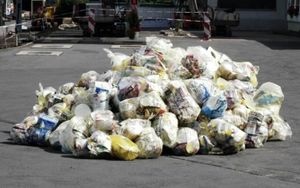IEHIAS question: example from waste: Difference between revisions
(Created page with "Category:IEHIAS Category:IEHIAS assessment methods :''The text on this page is taken from an equivalent page of the IEHIAS-project. ''As part of the E...") |
No edit summary |
||
| Line 23: | Line 23: | ||
In the pilot study, impacts were considered through a diagnostic assessment (i.e. only in terms of the effects of current exposures) in the three countries. It was quickly apparent, however, that the scale of impacts would vary greatly, depending on how management systems changed. The assessment was therefore performed in a region of Italy (Lazio) , in a prognostic form, to explore the potential impacts of two different management scenarios up until the year 2016, compared with a baseline in 2008. | In the pilot study, impacts were considered through a diagnostic assessment (i.e. only in terms of the effects of current exposures) in the three countries. It was quickly apparent, however, that the scale of impacts would vary greatly, depending on how management systems changed. The assessment was therefore performed in a region of Italy (Lazio) , in a prognostic form, to explore the potential impacts of two different management scenarios up until the year 2016, compared with a baseline in 2008. | ||
Downloadable copy of the pilot study [[File:WP_Waste_Assessment_Report _March 5_2009_.pdf | Downloadable copy of the pilot study: [[File:WP_Waste_Assessment_Report _March 5_2009_.pdf]] | ||
Revision as of 10:37, 6 August 2014
- The text on this page is taken from an equivalent page of the IEHIAS-project.
As part of the EU-funded INTARESE proejct, which contributed to the development of this Toolbox, a case study was carried out to assess the health impacts of waste management in three countries (Italy, England and Slovakia).

The initial question was: what are the health effects due to municipal solid wastes throughout their lifecycle, from collection to disposal or treatment under different scenarios?
Although this question appears relatively simple, it hides many complexities. For example:
- What types of waste management are we interested in?
- Wastes are treated and disposed of in many different ways, not all of them through official methods.
- What hazards and impact pathways are we most concerned about?
- Wastes may affect health at every stage in their life cycle, through a wide range of mechanisms, including the emission of many different pollutants into the air, water or soil, through direct contact with the wates during handling, and through industrial accidents and injuries.
- Over what timescale should the impacts be assessed?
- Landfill sites, for example, may continue to release pollutants into the environment for hundreds of years after they have been closed.
Ultimately, after much discussion and a pilot study, the question thus became:
What are the potential health effects from environmental pollution and physical injuries arising from the collection, transport and treatment/disposal (via mechanical and biological treatment, incineration and landfill) of muncipal wastes, under current and foreseeable waste management strategies?
In the pilot study, impacts were considered through a diagnostic assessment (i.e. only in terms of the effects of current exposures) in the three countries. It was quickly apparent, however, that the scale of impacts would vary greatly, depending on how management systems changed. The assessment was therefore performed in a region of Italy (Lazio) , in a prognostic form, to explore the potential impacts of two different management scenarios up until the year 2016, compared with a baseline in 2008.
Downloadable copy of the pilot study: File:WP Waste Assessment Report March 5 2009 .pdf